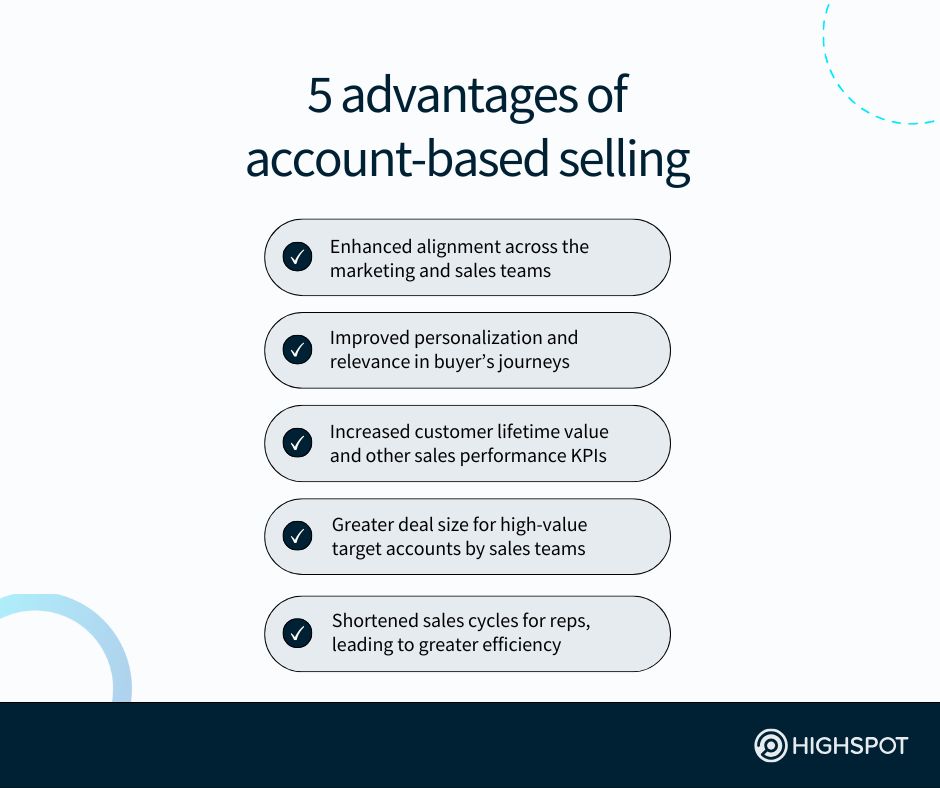Key Takeaways
- Executing data-driven, AI-powered 1:1 and 1:few account-based selling strategies geared toward high-value target accounts is how leading enterprise sales teams drive sustainable revenue growth.
- Without the right sales enablement technology to drive their ABS strategies, though, sales reps and account executives can’t collectively deliver captivating customer experiences that close deals efficiently
- Sales cycle length, pipeline velocity, win rate, and deal size all improve when go-to-market (GTM) teams work closely with one another on executing account-based sales and marketing campaigns.
Today’s B2B sales operations leaders—especially those at enterprises—face unprecedented challenges that demand fresh strategies and sharper execution across their sales functions.
Consider the issues your own sales team grapples with:
- Siloed sales tools and data that make it hard to act quickly on insights
- Overwhelmed sellers who waste too much valuable time on admin tasks
- Buyers who expect custom-tailored experiences in all sales touchpoints
- Limited visibility into what sales strategies and tactics actually drive revenue
- Scaling personalized sales approaches to better engage and convert leads
You may routinely fine-tune your account-based selling (ABS) approach, but, in 2026, minor changes are no longer enough to elevate your sales excellence and, in turn, better compete with emerging and established players in your respective space.
To meet rising buyer expectations and achieve predictable revenue growth, you need a smarter approach to ABS—starting with a revamped go-to-market (GTM) technology stack.
Modern account-based sales isn’t just about targeting the right accounts. You also need real-time insights, AI-driven guidance, and unified systems to engage leads with precision.
Only with this tech infrastructure, processes, and workflows in place can your reps:
- ID high-value accounts and target multiple key stakeholders at those companies
- Build a personalized outreach strategy by collaborating closely with GTM teams
- Craft 1:1 and 1:few marketing campaigns to nurture these key decision-makers
- Recognize the unique pain points and needs of decision-makers at target accounts
- Know what the right content is that they should then send to leads in their journey
Without modernizing your account-based selling strategy, your company is at serious risk of falling behind competitors who are actively investing in sales enablement; leveraging best-in-class, AI-powered tools, and executing cohesive GTM strategies that win key accounts.
Now more than ever, your ability to empower your sales team with the right data, insights, guidance, and solutions directly impacts your market position and bottom line.
The sales leaders who move swiftly to embrace changes to their ABM approaches won’t just enable their organizations to survive in the coming years—they’ll set their companies up to dominate their industries and verticals and drive unmatched revenue growth.
What is account-based selling?
Account-based selling is a strategic GTM approach that aligns sales and marketing teams around targeted, high-value accounts, enabling them to deliver personalized and consistent buying experiences across every interaction in their companies’ respective sales cycle.
Unlike traditional selling methods that focus broadly on all prospects, account-based selling leverages deep insights, real-time data, and intelligent tools to tailor messaging, content, and engagement to the priorities and preferences of key stakeholders within selected accounts.
Account-based sales seeks to maximize revenue impact by efficiently allocating resources and enabling one’s entire team of sellers—including inside sales and field sales—with precise guidance, empowering them to build meaningful, trust-based relationships that convert high-potential leads into loyal customers.
Think of ABS as the flip side of the account-based marketing coin: sales reacting to engagement of ‘warm’ leads that marketing initially connected with via targeted campaigns.
The advantages of account-based sales
It’s no secret account-based sales strategies offer many compelling benefits for sales organizations like yours, particularly those in highly competitive and complex B2B environments. The most notable advantages of ABS include:
- Enhanced alignment across teams: With a clear target-account list, sales, marketing, enablement, and even customer success teams collaborate effectively. This unity streamlines the sales process and enables personalized messaging tailored specifically to potential customers (and, in the case of customer success, existing customers deemed ideal for upselling and/or cross-selling).
- Improved personalization and relevance: An account-based sales approach also facilitates personalized sales messaging aimed directly at key decision-makers within target accounts, based on quantitative data and qualitative insights associated with those individuals stored in your customer relationship management (CRM) software and other business intelligence and GTM tools.
- Increased customer lifetime value (CLV): Focusing efforts on high-potential existing customers and qualified new leads at specific high-value accounts greatly enhances the odds of building and sustaining long-term relationships with those buyers. This, in turn, leads to higher customer satisfaction and retention, and, ultimately, steadily increasing CLV scores for those accounts.
- Greater deal size and revenue: When an account executive targets multiple stakeholders within an account, there’s an increased likelihood of addressing all the unique Jobs to Be Done (that is, pain points) of each decision-maker involved in the procurement process. This multi-threaded strategy often results in a larger deal size and higher overall revenue per account.
- Shortened sales cycle length: Tailored interactions and focused efforts on key decision-makers expedite buying decisions. As a result, your sales team is more likely to experience a reduction in its collective sales cycle length and turn engaged prospects into paying customers quicker.
The cumulative effect of a well-coordinated and -executed account-based selling approach is steady improvements in all key sales performance metrics tied to high-value accounts—not just retention, churn, and CLV, but also:
- Account engagement rate: Frequency and quality of interactions across target accounts
- Pipeline velocity: How quickly targeted leads move through stages of the sales process
- Deal size: Average monetary value of deals won within high-value, target-account list
- Win rate: Percentage of deals successfully closed compared to opportunities pursued
- Sales cycle length: Average amount of time it takes to close deals with prospects
- Stakeholder engagement: Number and seniority of decision-makers actively engaged
- Meeting-to-opportunity conversion rate: Percentage of initial sales discovery calls that turn into qualified sales opportunities (based on your own qualification criteria)
- Revenue per account: Average total revenue generated from each target account
- Account penetration: Breadth and depth of relationships built within each account
Reps and account executives are focused on tactical execution (like building account-centric sales plays) to influence these key performance indicators (KPIs), among others.
However, sales leaders can put those sellers in position to implement account-based selling activities that convert by giving them cutting-edge, GTM enablement technology.
More specifically, they need a sales enablement tool that has built-in AI and analytics that empowers them to know everything about target accounts as they move through the funnel.
“With an unparalleled ability to use data and insights to drive outcomes, the deep-sales approach can help sales leaders and their teams unlock more opportunities,” LinkedIn Global VP of Sales Solutions Alyssa Merwin recently wrote for Harvard Business Review.
“It’s an approach that leads to faster deal cycles, higher win rates, and revenue growth: a seismic shift in the evolution of B2B selling,” Merwin continued.

Account-based selling strategies in action
We’ve covered the basics of account-based sales—ones you’re well-aware of.
Now, let’s highlight a couple ABS strategies executed at real enterprise organizations across industries and see how each company makes the most of a GTM enablement platform, specifically, to help their teams sell smarter.
Elsevier executes a highly coordinated ABS strategy
Though Elsevier, a global information analytics company, initially only onboarded Highspot’s sales enablement platform to better organize its content to make it more easily accessible and discoverable by reps, it quickly discovered it could aid with facets of its ABS strategy.
Highspot’s AI-powered meeting intelligence enables smarter coaching to individual reps.
This advance sales capability helps reps improve their tone of voice and cadence on sales calls, how they handle specific buyer objections, and ensure they touch on specific value propositions of interest to target accounts.
“That AI piece is really key to helping us long-term so we can do more and more coaching,” said Elsevier Manager of Sales Enablement Stacy Ardoin, noting both rep confidence (65%) and buyer engagement (30%) have increased since adding Highspot to its GTM toolkit.
Zappi gains visibility into ABS content effectiveness
Zappi, an agile consumer insights platform, needed a way to deal with governance and permissions issues when sharing account-based selling collateral externally with prospects.
These issues, along with a desire to have reps personalize account-based communications at scale, led Zappi GTM leadership to invest in Highspot.
Now, with our enablement software at the heart of its sales tech stack, Zappi sales reps can see what assets resonate most within accounts at large and specific stakeholders, allowing them to pivot their sales process and plays as needed. Similarly, Zappi’s enablement function can see which collateral reps use the most to pitch prospects
“By using analytics and trends within Highspot, we can truly see how engaging a piece of content is, what is being searched for, and what is being shared the most,” said Zappi Head of Sales Enablement John Hunt.
How the account-based selling model has evolved
Account-based sales has been around for a while. Since its formalization, it has been adopted by the overwhelming majority of B2B brands worldwide—and evolved a lot.
To know how to best optimize your account-based selling strategy (and improve the KPIs above), you need to know what has changed with the sales model in recent years and why.
Adjusting to B2B buying process changes
Today’s B2B buyers are more independent than ever. They often spend a lot of time researching and gathering information before even speaking with reps.
This shift means your sales strategy needs to become more proactive and personalized, closely aligned to each distinct buyer persona you target.
To keep pace, align your sales and marketing efforts to deeply understand the specific pain points and motivations of your buyers. Doing so helps your reps deliver only the most timely, relevant content. Consider digital sales rooms.
Information-overload from their research means many “buyers struggle to reconcile conflicting or incorrect information, making it difficult to make an informed decision,” per Highspot’s “The Power of Digital Sales Room for B2B Sales” guide.
In short, dynamic and interactive digital sales rooms can act as a bridge between buyers’ online and real-world research and the initial discovery call with a rep.
In Highspot, reps can easily and quickly create personalized DSRs that feature sell sheets, brand-explained videos, product demos, and other sales collateral they believe can best answer leads’ questions and fill in any informational gaps they couldn’t fill on their own.
Watch our video to learn how Digital Sales Rooms enable reps to sell smarter.
Utilizing AI and analytics in selling more
Advanced AI and analytics are table-stakes for all account-based approaches today.
Turning AI-driven insights into ABS actions and optimizations can help your team accurately identify valuable customers and pinpoint which specific accounts deserve the most attention and resources by your vertical- and territory-focused sales teams.
This targeted approach means your sales reps and account managers alike can better prioritize their ABS efforts, focusing energy on new customers most likely to convert.
Additionally, you’ll boost your chances of lowering customer acquisition costs and elevating average revenue per account by connecting with only the ‘right’ accounts.
Using sales engagement data in a sales enablement platform like Highspot, you could generate granular insights into which sales collateral and emails are opened, read, and viewed and which account stakeholders are most and least engaged.
Enabling reps to improve their performance
Improving your team’s sales performance is no longer about implementing traditional training programs and one-size-fits-all coaching sessions.
Strategic account management requires personalized coaching—led by, not solely executed by, managers—that adapts to each target company’s unique context and business goals.
By regularly upskilling your reps with tailored, continuous coaching, you’ll ensure they’re prepared to tackle complex sales-cycle challenges as they arise and deepen relationships with key stakeholders at high-value accounts.
This can boost your customer satisfaction score—not just with closed-won accounts, but also closed-lost and no-decision ones who appreciate your personal touch across ABS activities.
It can also foster stronger customer relationships with target accounts and boost the likelihood you retain their business long-term (and possibly get referral business from them).
Improving your account-based sales strategy
“Every customer invested in your solution for a different reason and, therefore, has a unique concept of what value looks like,” Highspot’s “A Versatile Strategy for Customer Value” guide explains. “Preventing churn, powering expansion, and forging long-lasting customer partnerships all come down to your ability to accommodate and support this variance.”
Translation? Your company’s ABS strategy isn’t just about winning new, high-value customers. It’s also about ensuring those customers remain as such for the long haul.
That means you need an account-based selling platform that enables your sales and marketing teams to deliver bespoke experiences:
- Pre-sale: Before you’ve had even a single conversation with a lead
- Mid-sale: When reps are hard at work unearthing prospects’ needs
- Post-sale: When account managers and customer success teams take the reins from your sales reps to keep customers happy.
Your CRM and business intelligence tools play pivotal roles in your ABS efforts—but it’s a GTM performance platform with sales enablement capabilities, including AI-powered capabilities, that will ultimately dictate the success of your account-based approach.




